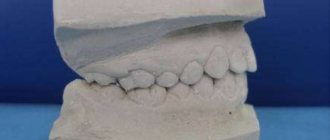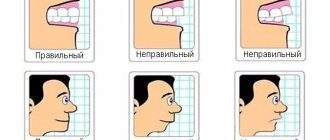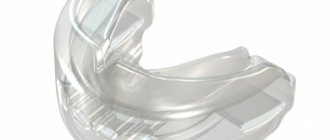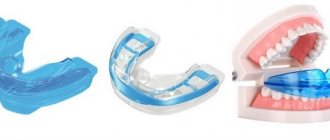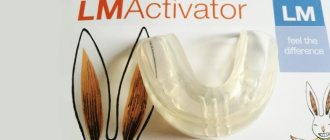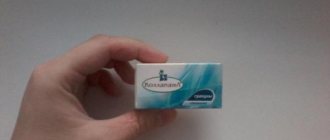A dental trainer is an orthodontic device designed to eliminate the causes of dental anomalies in children and adults. This device is made in the form of a mouthguard and is made of elastic silicone. The trainer's operating mode is quite mild, the device does not need to be worn all the time; it is enough to use it during the day, from one to three hours, and put it on during night sleep. What is a trainer
A trainer is a ready-made orthodontic device that does not require a cast of the jaw during manufacturing. It is produced in one universal size and requires virtually no adjustment, except in cases where it is necessary to trim the ends to fit the length of the jaw.
Trainer design features:
- It has arched recesses for the dentition.
- Equipped with a special “tongue” that fixes the natural position of the tongue.
- Has lip bumpers that relieve muscle pressure.
- In the trainer, the jaw is in its natural position, i.e. in an ideal bite.
When a doctor recommends correction with trainers
Trainers are used to straighten teeth when a patient is diagnosed with a malocclusion. Pathology can have different manifestations, so the possibility of wearing a corrector to obtain an effective result is assessed by the orthodontist individually for each patient.
In certain cases, trainers can replace a brace system if they have contraindications to wearing it. However, the corrective abilities of trainers are inferior to braces, although only slightly.
Other indications for wearing orthodontic trainers:
- deviation in tooth growth (location, direction, etc.);
- swallowing dysfunction;
- pathologies of the oral cavity leading to chronic nasal congestion.
The peculiarity of the device lies in its effect on the cause of the disease. Wearing trainers helps develop the jaw muscles, reduce pressure on the jaw bones, restore breathing through the nose and correct tongue position.
How long do you need to wear trainers to get perfect results?
To achieve this goal, trainers must be worn at least 10 hours a day - sometimes longer. At night - a must.
Since the patient receives a set of trainers, there is a certain sequence in wearing them. The first soft (pink) trainers are worn for 6 to 9 months, and the harder (blue) ones are designed to be worn for 5 to 12 months.
Depending on the diagnosis and individual characteristics of tooth mobility, treatment with trainers can take from six months to two years. But at the end of the day, the patient gets an ideal result - straight and healthy teeth, no ENT problems, speech becomes clearer, facial features are more harmonious. All this is the path to a healthy future and self-confidence!
Dentists at the Zuub clinic specialize in treating children and adult patients with trainers. High-quality devices in an affordable price segment, treatment support with turnkey trainers, predictable results, individual approach to everyone. Possible combination with wearing braces. Sign up for an initial consultation to take the first and most important step towards straight teeth and health!
For whom are they contraindicated?
Correction with an orthodontic device to correct the bite may not always be carried out. Experts advise postponing the start of treatment in case of exacerbation of chronic diseases, especially those associated with impaired nasal breathing.
There are no significant contraindications. In addition to the listed limitations, treatment is not recommended for lateral crossbite. In case of hyperactivity and uncontrolled behavior of a child, correction takes place under the strict supervision of parents and a doctor.
If there are contraindications, you can choose another method of correcting the bite. Based on the clinical picture and characteristics of the child’s psycho-emotional behavior, the clinic’s specialists will select the most effective system that will not pose any risks to the child’s health.
Indications and contraindications
Main indications for use of the trainer:
- deformation of the dentition due to bad habits;
- deep bite, cramped teeth;
- malocclusion in the anterior region;
- collection of teeth in the frontal region of the lower jaw;
- difficulty swallowing, speech defects, etc.
List of contraindications to the use of trainers:
- pronounced crossbite, when the frontal incisors of the mandibular row are located in front of the upper teeth;
- crossbite in the lateral areas;
- mental problems;
- difficulty breathing with a severe runny nose.
Advantages
An orthodontic trainer is a product similar in appearance to mouth guards. The device is made of polyurethane or silicone.
Advantages of correction using mouth guards-trainers:
- in terms of their effectiveness they are not inferior to braces (with the exception of complex bite pathologies);
- do not require round-the-clock wearing;
- installed for only a few hours a day;
- allow you to avoid aesthetic defects that arise during treatment with braces;
- ease of care (regular toothpaste and toothbrush are suitable);
- there is no effect on tooth enamel and soft tissues;
- mechanical injuries are excluded;
- elimination of the cause of the pathology, the disease itself and its consequences;
- do not require individual manufacturing, since the device has a universal size.
The popularity of the corrector is also explained by its cost. The price for trainers for straightening teeth is three times lower than for braces. The disadvantages include the need to strictly adhere to treatment tactics.
Care instructions
The rules of care are very simple:
- After removing the trainer from your mouth, you must rinse it with running water;
- periodically it needs to be cleaned with a toothbrush and toothpaste;
- the device should be stored in a special container;
- While the trainer is in the mouth, patients are prohibited from talking or opening their mouth;
- the structure cannot be chewed, gnawed, boiled, or washed with very hot or very cold water;
- Once every one or two months you need to see an orthodontist to evaluate the results;
- In case of mechanical damage, the device should be immediately taken to the orthodontist.
Category Orthodontics Published by Mister stomatolog
Types of dental trainer models
Bite pathology can be of different types. The design has an element at the base, which exerts varying degrees of pressure on the teeth. They produce soft, medium and hard correctors. Depending on the complexity of the defect, a trainer is selected according to the degree of rigidity. Orthodontic products are distinguished by their intended use.
Pre-orthodontic
Preorthodontic trainers are a device that is designed to correct dental growth pathologies in children with primary teeth. This model has no analogues.
Two types of construction are produced, taking into account all the features of the period of change of baby teeth:
- Infant - for 4–6 years;
- T4K - for 6–10 years.
Pre-orthodontic trainers can also be used to prevent malocclusion, under the influence of provoking factors:
- constant breathing through the mouth;
- hypertonicity of the temporomandibular joint;
- bad habits (finger sucking, nail biting, etc.);
- improper teething.
Wearing a trainer is also recommended in case of premature loss or removal of baby teeth. It is necessary to wear such a design until the teeth erupt, regardless of the age at which they were lost.
Finishing
Orthodontic trainers of the “finish” type can be recommended by a specialist to be worn by a child aged 10 to 13 years. They are prescribed mainly for preventive purposes after wearing other correctors, to strengthen the enamel if the child is prone to bad habits, to reduce muscle tone and form a swallowing reflex.
Orthodontists also prescribe this device after wearing braces to consolidate the result or to correct defects that have arisen after the removal of the braces. In this case, you will need the finishing model or, as it is also called, “retainers.”
If the bite is corrected with braces, then long-term wearing of retainers is considered a necessary measure used to prevent the reverse displacement of teeth.
For braces
A special type of therapeutic trainers for braces. Both orthodontic devices are used simultaneously, but only in certain cases:
- increased muscle pressure;
- protection of oral tissues from damage at night;
- bad habits.
With complex correction, it is possible to achieve the results of functional and hardware treatment, increasing the effectiveness of both structures.
Orthodontic treatment methods are the treatment of anomalies in the development of the dental system using special orthodontic devices. At the same time, some irregularities in the shape of the face are eliminated, the acts of chewing, breathing and speech are normalized, irregularities in the location of the teeth, the shape and relationship of the dentition are corrected. Now there are many different orthodontic appliances. One of the most popular nowadays are orthodontic trainers.
Today we’ll talk about orthodontic trainers for teeth, their types, indications for use and much more.
1. What are trainers?
2. Indications.
3. Contraindications.
4. The difference between trainers and other orthodontic devices.
5. Types and models of trainers (orthodontic trays)
6. Proper care.
What are orthodontic trainers ?
Photo of the trainer.
Trainers are removable silicone or polyurethane orthodontic devices (mouth guards, splints) that are designed to correct anatomical bite defects. They can be considered an alternative to brace systems, which should solve the same problems. The main difference from other designs that are used in orthodontics, in addition to their appearance, is that the trainer is designed to eliminate the causes of defects.
Trainers help straighten teeth and eliminate excessive pressure on the maxillofacial muscles or bad habits (tongue sucking, finger sucking) that lead to abnormal bite formation.
An important difference between a trainer and braces or orthodontic plates, which have a mechanical effect on the teeth, is that the splints eliminate the cause of the development of the anomaly, and not its symptoms. In addition, the unique shape of the trainer, made of elastic silicone, gently relieves excessive muscle pressure on the jaws and teeth, making it possible to consolidate the achieved results and eliminate the possibility of relapses.
The purpose of wearing orthodontic trainers is also to bring the tongue into the correct position and form nasal breathing.
Such structures are made from polyurethane of varying hardness, which has the properties of an elastomer. An elastomeric material is one that has very high elasticity. The polymers used are safe as they do not cause allergies.
Main indications for using the trainer: Let's consider anomalies in the development of the dentofacial system, which are indications for wearing the device:
- The inability of a person to use braces for one reason or another;
- malocclusion - deep and open;
- in the frontal part of the lower jaw there is pronounced crowding of teeth;
- some speech therapy problems;
- improper swallowing;
- consolidation of the results of orthodontic treatment;
- rotation of canines and incisors;
- bad habits, such as: sucking the thumb and other objects, inserting the tongue between the lower and upper teeth;
- dental trainers are made from hypoallergenic materials and therefore can be used even by patients prone to allergic reactions;
- psychological problems;
- nasal congestion.
- pain and excessive stress on the TMJ.
Contraindications:
The main disadvantage of trainers is the fact that they may not be effective in all cases. Contraindications for use are: severe nasal congestion, complex cases of malocclusion or dentition. In this state of affairs, it is impossible to correct the anomaly without mechanical action.
The difference between trainers and other orthodontic devices.
The main difference between trainers and other orthodontic devices is their practicality. Unlike braces, they do not need to be worn constantly. They are worn at night and for a couple of hours during the day.
It is also worth noting other advantages:
- easy installation
- the elasticity of the structure does not injure the oral cavity
- convenience and use of the device at night
- invisibility of the device
- minimal discomfort
- easy to care for
- acceptable price
But it is worth noting the minimal number of disadvantages in using these devices:
- it is not possible to talk when the device is installed,
- The final result directly depends on the patient, on his responsibility in regular use of the device,
- low effectiveness for complex anomalies.
How to wear dental trainers?
The device is placed in the oral cavity, the tip of the tongue should be located in the “tongue” of the trainer. Then you need to close your teeth and lips and breathe through your nose.
Types and models of trainers.
There are different classifications of dental trainers, depending on the functionality and purpose of the devices.
According to their functional purpose, trainers are divided into:
- initial ones are soft devices with good elasticity, which allows the patient to quickly adapt. The average lifespan of initial trainers is about 6-8 months, most often they are blue in color.
- the final ones are orthodontic aligners, repeating the shape of the initial ones, but made of less flexible materials. The duration of use of final trainers, as a rule, is also limited to 6-8 months, after which most causes of malocclusion are usually eliminated, usually made of pink silicone or polyurethane.
- retainers - these devices are designed to consolidate the results of orthodontic treatment and prevent relapses.
Trainer models are also classified according to their intended purpose.
The following types of dental trainers are distinguished:
1. trainers for babies TRAINER T4I INFANT
During the formation of the dental system in children, various pathologies often arise. This may be a malocclusion, incorrect position of the lower jaw, crowded teeth, etc. Trainers are a good way to correct such defects in the early stages, as well as to prevent them . These are special silicone splints placed in the oral cavity, which help eliminate the main causes that give rise to these pathologies. Special trainers are produced for children (t4ki INFANT soft (blue) and t4ki INFANT soft (pink) ) from two to five years. They dress for 10 – 15 minutes twice a day. These simulators replenish the load on the oral muscles, help develop the correct position of the tongue when swallowing and at rest, and also eliminate interdental sigmatism. The range of trainers for children from five years of age is designed to consistently eliminate the most common dental development disorders and consolidate the achieved results. They are worn during sleep and for 1 – 2 hours during the day. Trainers for babies are completely safe. They are made of hypoallergenic materials, wearing them is absolutely painless and usually does not cause psychological rejection. They are contraindicated only in case of particularly severe defects of the dental system.
T4K PRE-ORTHODONTIC TRAINERS
Pre-orthodontic trainers T4K blue and T4K pink (red) are widely used by orthodontists to solve the problem of malocclusion from childhood (5-10 years), speech defects and atypical position of the lower jaw.
3. TRAINERS FOR LEVELING T4A
Disturbances in the structure of the dentition are currently one of the most common pathologies of the dental system. Incorrect bite is not only not aesthetically pleasing, but also causes other dental diseases (wearing off enamel, gum disease, difficulties with oral hygiene, impossibility of dentures, etc.)
Currently, special trainers are produced for leveling T4A blue (blue) and T4A pink (red) . These are elastic splints made of silicone that are placed in the oral cavity during sleep and for a short time during the day.
4. TRAINERS WITH MYOBRACE
New orthodontic devices of the Myobrace series with a two-layer design combine the advantages of soft flexible silicone, which forms the outer layer, and a hard inner layer, which forms an elastic frame that stimulates the growth and expansion of the patient’s dental arch. These devices can also be recommended for use during the period of retention when correcting crowding of teeth in the anterior region.
Myobrace series devices are available in 7 sizes:
- Myobrace trainer, size MB1 - distance of the first 4 incisors - 30mm
- Trainer Myobrace, size MB2 - distance of the first 4 incisors - 31.5 mm
- Myobrace trainer, size MB3 - distance of the first 4 incisors - 32.5mm
- Trainer Myobrace, size MB4 - distance of the first 4 incisors - 33.5mm
- Myobrace trainer, size MB5 - distance of the first 4 incisors - 35 mm
- Trainer Myobrace, size MB6 - distance of the first 4 incisors - 36.5 mm
- Myobrace trainer, size MB7 - distance of the first 4 incisors - 38.0 mm.
5. TRAINERS FOR CORRECTION (SERIES I-3; I-3N; I-2; I-2N)
Trainers for dental correction are usually prescribed to children aged 5 years and older, when malocclusions are in their initial stages. The treatment takes place in two stages. At the first stage, soft trainers are prescribed, to which even a small child quickly and easily adapts. The second uses more rigid models designed to consolidate the achieved result. Typically, the mode of wearing trainers is as follows. They are worn at night and for one hour during the day. The initial (soft) trainer is worn for six months, and the final (hard) trainer is worn for six months to a year. The regimen is prescribed by the dentist strictly individually depending on the patient’s characteristics. In cases of bruxism (involuntary grinding of teeth during sleep) or mild disocclusions, they immediately begin with a hard trainer.
LINGUA BRACES T4CII; Т4В
The braces trainer is a modern and reliable device that allows you to solve many of your child’s dental problems. If you want him to grow up healthy and happy, you should pay special attention to his teeth from early childhood. A dental trainer is a great way to quickly and painlessly correct orthodontic problems and give your child a carefree childhood.
The development of malocclusion can be caused by various factors. This can be either bad habits or muscle dysfunction. Therefore, very often after wearing braces, problems return again. As a rule, dental problems begin in children during the active change of milk teeth to molars or later.
Trainers for braces. They serve as an addition to the main treatment of occlusion with braces, and also protect gum tissue from damage by elements of braces; joint trainers. Designed to relieve tension and pain in the jaw muscles.
7. TRAINERS FOR BRUXOGARD BRUXOGARD
The bruxism trainer was designed specifically for children 2-5 years old. It is very easy to use and helps eliminate bad childhood habits such as thumb sucking, interdental tongue thrusting and mouth breathing, and also stimulates the tone of the orbicularis oris muscle and allows children to perform chewing movements to train muscles and stimulate jaw growth - such movements have a cleansing effect. impact on teeth. The trainer cannot be swallowed and can easily be placed in children's mouths; however, the child must be supervised by an adult while using the trainer.
8. TRAINERS TO PREVENT SNORING TMJ-MBV
The new tmj.mbv device features large ventilation holes and a base with air shock absorbers enlarged to 7 mm, allowing lateral and AP movements of the lower jaw during sleep, as well as mild decompression in the TMJ area. Most anti-snoring therapy devices rigidly fix the lower jaw in an anterior position, which can cause damage to the TMJ. The TMJ-MBV splint allows movement of the lower jaw, which is preferable if the patient has TMJ dysfunction.
The sides of this device are much higher than those of a conventional joint splint, which makes its use more comfortable - it does not fall out of the patient’s mouth during sleep. TMJ.MBV allows the patient's lower jaw to be pushed forward, while the height of the bite increases due to the thickness of the base, which helps to increase the lumen of the oropharynx. The device is made of flexible silicone, which allows free movement of the lower jaw during use, making it ideal for TMJ dysfunction.
TMJ AND TMD JOINT SPRINTS
The joint splint has a thickening in the area of the molars, which promotes mild decompression of the joint. Thanks to the flexible silicone base of the splint, a relaxing effect is created on the muscles in the area of the TMJ joint, head and neck, which leads to an immediate reduction in pain. Habits such as bruxism and clenching teeth under stress are limited - tension is relieved thanks to the patented wing-shaped base, as well as the double-jaw design of the splint: in the splint, the lower jaw moves forward. the relative position of the jaws is set according to class I. Over time, this helps eliminate chronic pain in the joint area. The main symptoms of TMJ dysfunction are eliminated within a few days, but to relieve chronic pain, wearing the device for several weeks is required. The joint splint should usually be worn for 1 hour during the day plus overnight. The duration and mode of wearing are individual and should be determined by the attending physician according to indications.
It is not difficult to distinguish the listed types of trainers , since they are indicated by certain markings. For example, dental trainers for adults are T4A, trainers for braces are T4B, trainers for children are T4K and T4Ki. And although such devices are available for free sale, you should not purchase trainers on your own, without a doctor’s recommendation. The fact is that dental trainers should be used as part of an orthodontist-planned treatment that takes into account the patient's specific malocclusions. Only then can you count on getting an effective result.
A diary of daily work with the trainer will be an excellent addition to improve the results of treatment, as well as constant monitoring of wearing trainers
The diary contains additional information on the rules of training trainers. You can also find many useful exercises for the development of the myofunctional system.
The description in the diary is written in a language accessible to children and all exercises are presented in the form of a game.
This diary will help you and your child on the path to achieving better treatment results.
Trainer care
Dental devices are quite easy to care for:
- It is recommended to store the trainer in a special plastic container.
- You should clean it periodically with toothpaste and a brush.
- Inspect for mechanical damage. If they are detected, you should consult your doctor.
- Trainers must be worn very carefully: you cannot chew, bite, or try to move them in your mouth. You cannot talk while wearing the device.
- After each use, rinse the tire under running water.
- Do not boil it or wash it with very cold or hot water!
Let's summarize.
Dental trainers are designed to correct various types of malocclusion; they are also good at weaning, especially children, from bad habits that can provoke the appearance of abnormalities in the development of the temporomandibular joint.
They are suitable for the final stage of forming an anatomically correct bite after treatment with braces.
Also, in some cases, they are effectively used to combat snoring and some speech defects caused by the pathological placement of the lower jaw in the oral cavity.
With the help of trainers, incorrect position of the front teeth, such as twisting, is corrected. Most trainers are designed to relieve excess pressure from the jaws and muscles on the joint apparatus of the oral cavity.
These devices are very convenient to use. They are easy to keep clean and do not cause physical discomfort during use.
Thanks to strong, and at the same time quite elastic materials, they are difficult to deform and render unusable.
Modern dentistry also distinguishes children's trainers from adults in their functionality. They solve various problems based on the age characteristics of the patient.
These orthodontic structures are not effective in correcting serious disorders of the dentofacial apparatus. These are fairly narrowly targeted therapeutic devices. But they do a good job of solving the problems they were originally designed for.
Advantages of trainers over other correctors
When analyzing the action and effectiveness of all orthodontic devices for correcting malocclusion, according to the opinions of orthodontists, trainers have three main advantages:
- do not require constant use - the factor of non-aesthetic teeth, which often causes discomfort in society, especially among children, is eliminated;
- lack of pressure on the teeth - the effect is on the entire jaw by limiting the freedom of space, but without the absence of directional pressure;
- ease of installation - the patient can remove and install the trainers independently without additional assistance from a specialist.
Reviews of dental trainers confirm the effectiveness of the design, but only if all operating rules are observed, including indications and treatment regimen. In patients who violate correction tactics (irregularly wearing the device), the treatment result may not correspond to the expected one.
Cost of dental trainers
The price of dental trainers is much lower than installing braces or surgical treatment. The amount varies from 2000 to 6000 rubles. Before using the device regularly, you will definitely need to consult a specialist, which can be done in a private office or clinic.
Dental trainers should only be used regularly if prescribed by a doctor. The specialist will determine a list of physiological disorders and also assess the prospects for treatment.
This article is for informational purposes only, please consult your doctor for details! Ask your doctor about contraindications and side effects.
Features of treatment with trainers
A malocclusion can be noticed independently or diagnosed by a dentist during a routine examination. The need to wear trainers is determined by the orthodontist based on the results of consultation and diagnosis.
The corrector must be worn from 1 to 4 hours a day. The treatment regimen is determined by the doctor. It is not recommended to reduce the operating time of the device. You should choose the most convenient period during the day.
Orthodontists recommend wearing a trainer in the evening, since while the device is in the mouth, you cannot talk, drink or eat. Habituation occurs within a week. If a corrector is prescribed to be worn at night, then the child is monitored during the first month, since the trainer may fly out or the child involuntarily removes it.
The average duration of treatment is one year. During this period, you should visit the orthodontist every 2-3 months to monitor the changes that are occurring.
Trainers for straightening teeth are considered the most effective corrector for malocclusion pathologies. You can install an orthodontic device at the Martinka Clinic. Our specialists provide an individual approach to choosing a product model and determining a bite treatment plan. You can make an appointment with an orthodontist, find out how much teeth straightening trainers cost, or other information by calling or visiting the pediatric dentistry website.
Why are trainers better than other orthodontic devices?
The main advantage of trainers, as opposed to braces, is comfort and ease of use. The device does not have to be worn all the time; it can be worn at night or for just 2 hours. This mode is quite convenient for serious people and teenagers who are concerned about aesthetics and do not want to disturb the attractiveness of their smile with foreign objects in their mouth.
Long-term use of trainers does not cause discomfort or pain, and does not provoke injuries to the soft tissues of the mouth. The design does not put pressure on the teeth and does not irritate the mucous membranes in the oral cavity.
Pros and cons of trainer systems
Each orthodontic design has its own advantages and disadvantages, which dentists take into account. Trainers have many benefits if used correctly.
| pros | Minuses |
| • High aesthetics: transparency, pleasant shine, small size. • Can only be worn at night for best results. • No discomfort during use (which is especially important in childhood). • Moderate cost of structures in comparison with braces and aligners. • Easy to maintain the trainer, no special equipment required. • Easy to use: quick to put on and take off. | • Effective only for minor changes in tooth alignment, but not suitable for severe malocclusions. • The treatment process is long, the first results do not appear immediately. • Great attention to the time and correctness of wearing (for children, parents should do this). Failure to comply with the dentist's recommendations may reduce the effectiveness of treatment. |
Smile dentists are attentive to their clients, so the choice of a suitable bite correction system is carried out jointly. The doctor will tell you in detail all the advantages and disadvantages of specific designs so that the patient can decide on the best option for himself.
Patient reviews
“Trainers are a very good way to remove slight crooked teeth, as it turns out. Having made an appointment, I expected to wear braces or aligners for a long time, but in the end I completely straightened my teeth in a fairly comfortable and budget-friendly way. Thank you to the doctors at the clinic for suggesting this method, which I had never heard of before.” Kirill, 26 years old
“My child had a not very good habit of sucking his fingers, and an incorrect bite had even begun to form because of this. At the dentist's appointment, trainers were recommended. At first, I doubted the effectiveness because I didn’t notice any significant changes. A few months later, in addition to the fact that my son got rid of his bad habit, I began to notice that his teeth were gradually falling into place. After another six months, she noted that the dentition had completely straightened out. I’m very pleased with the result and thanks to the doctors at the clinic.” Oksana, 45 years old
“I noticed the displacement of my daughter’s teeth too late, so I began to prepare for long-term wearing of braces. But the doctor advised me to use trainers while the bite is changing. The main task was not to aggravate the situation. But I must say that after 8 months of wearing it, my daughter’s teeth began to look much better. I would also like to note the absence of unpleasant sensations when wearing them, since my daughter calmly put on the trainers every day and was not afraid to walk in them.” Marina, 40 years old
Conclusion: Trainers are specific orthodontic structures for correcting minor bite defects or preventing their formation. They are used mainly in children, but can also be used in adults. Dentists at the Smile clinic offer effective treatment with trainers according to indications with a guarantee of a positive result.
Construction of simulators for teeth straightening
The first dental trainers were invented just over 20 years ago by the Australian company Myofunctional Research Co. Exercise machines are made from polyurethane and silicone and come in soft (blue or blue) and hard (red or pink).
Externally, they look like mouth guards for the upper and lower jaws, which consist of:
- recesses for teeth;
- lip bumper;
- labial arch;
- internal tongue stop;
- marker tongue.
The trainers have a universal shape, so when installing them there is no need to additionally take impressions and waste time on the production of an individual device.
The devices correct the bite gradually and almost imperceptibly.

